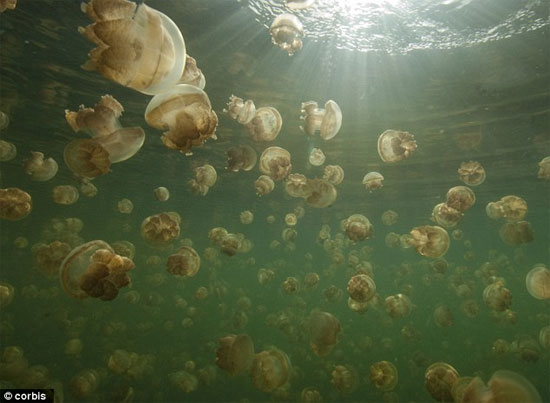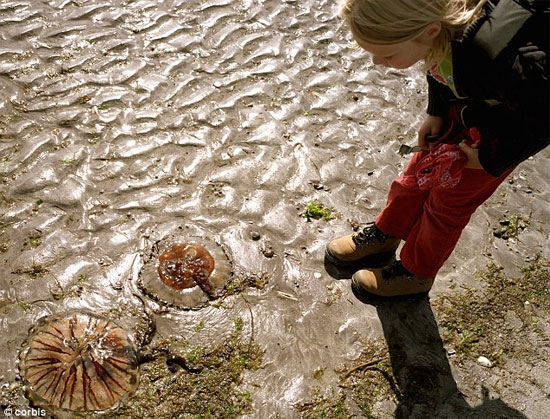Jellyfish species can 'knock down' American carriers
Jellyfish and sea creatures have appeared on Earth since about half a billion years ago, possibly more dangerous than our long-held concept. They can even attack nuclear plants.
>>>Seeing the sexy beauty "mermaid" mermaid
Lisa-ann Gershwin's new book, "Stung! On Jellyfish and the Future of the Oceans" describes how dangerous jellyfish are, as well as how they have destroyed ecosystems. Much of this creature's power, according to Gershwin author, originates from their life cycle.

Jellyfish are proliferating in harsh environments, when other species are dying and dying.(Photo: Corbis)
Dr. Gershwin draws on the characteristics that make up jellyfish's power as follows: "Bisexual. Clonal breeding. External fertilization. Self-fertilization. Flirting and mating copper meat ".
A jellyfish called Mnemiopsis , capable of laying eggs when only 13 days old without a partner. They can also quickly lay up to 10,000 eggs a day. In addition, the jellyfish Mnemiopsis can eat up to 10 times their weight and double their size each day.
Some other jellyfish are also extremely difficult to destroy. When faced with death, they can "grow backwards" , ie reduce size but still maintain the balance of the body. In particular, zombie jellyfish (zombies live) seem immortal. When the body particles disintegrate, the cells will escape and form a completely new jellyfish body. This development takes place within 5 days.
Gershwin said that complex ecosystems often put jellyfish into the final step. However, human intervention and manipulation spurred development and helped the population of this organism grow to an explosive level.

Jellyfish appear more and more on beaches around the world.(Photo: Corbis)
Gershwin said that overfishing of fish - the competitor of food with jellyfish, created giant jellyfish colonies in South Africa. The jellyfish's opponents quickly die, leaving a "viscous slaughter area".
Floating ball and rope pockets can destroy some creatures that eat natural jellyfish like sea turtles. Meanwhile, jellyfish use solid waste such as industrial waste to create a large nourishment area.
Elevated acid and carbon dioxide levels have been reported to have killed many different species of fish. However, jellyfish reproduce in such harsh environments. They release high-carbon waste and bacteria use this carbon to create "carbon dioxide plants".
A good example of this is in the Gulf of Mexico in 2000, when jellyfish invaded an area of 155.4 km 2 . They survived the sweep of the storm that destroyed Katrina and the 2011 Gulf oil spill, while thousands of other creatures were destroyed.

Jellyfish thrive in the harsh environment of the Gulf of Mexico, where thousands of other organisms die
Gershwin writes that two types of Irukandji box jellyfish and jellyfish have killed dozens of people. Specifically, box jellyfish can kill people within 2 minutes; Irukandji jellyfish, which can cause cramps, spasms and vomiting, massacred numerous victims. Many deaths from jellyfish have been mistaken for stroke or heart attack.
When in groups with a large number of jellyfish, there is the possibility of "obstructing" strange, Ms. Gershwin wrote. They are able to snuggle into suction pipes or wear on heavy structures. For example, in July 2006, jellyfish stuck to the US Ronald Reagan aircraft carrier, disabling the carrier's operational capabilities. Japanese nuclear power plants have also been put on alert for "being attacked by jellyfish" since the 1960s.
- China seeks to destroy the jellyfish protecting the aircraft carrier
- Beautiful sparkling jellyfish kingdom
- Startled with the danger of jellyfish invading the oceans
- The first purple jellyfish on the planet
- Detecting the US carrier's body from World War II
- 65 interesting things about jellyfish (1)
- Strange jellyfish species without tentacles caught
- 65 interesting things about jellyfish (2)
- Do you know how jellyfish burn us?
- Beauty of jellyfish in the dark
- Cure stinging jellyfish
- Jellyfish cannot 'invade' the planet
 Surprised: Fish that live in the dark ocean still see colors
Surprised: Fish that live in the dark ocean still see colors Japan suddenly caught the creature that caused the earthquake in the legend
Japan suddenly caught the creature that caused the earthquake in the legend A series of gray whale carcasses washed ashore on California's coast
A series of gray whale carcasses washed ashore on California's coast Compare the size of shark species in the world
Compare the size of shark species in the world Scene of more than 150 tons of jellyfish destroying a power plant in China
Scene of more than 150 tons of jellyfish destroying a power plant in China  Magical images never seen before in jellyfish
Magical images never seen before in jellyfish  Find out 'Frankenstein's monster' reassembled 2 body pieces to continue living
Find out 'Frankenstein's monster' reassembled 2 body pieces to continue living  Scientists decipher the secret of the immortal jellyfish's longevity
Scientists decipher the secret of the immortal jellyfish's longevity  How jellyfish stings and how to treat jellyfish stings
How jellyfish stings and how to treat jellyfish stings  Scientists have just discovered a way to read the mind of jellyfish, which have no brains
Scientists have just discovered a way to read the mind of jellyfish, which have no brains 